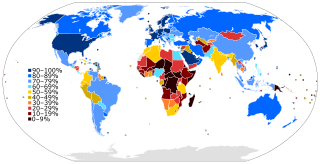Telecommunications in Ireland operate in a regulated competitive market that provides customers with a wide array of advanced digital services. This article explores Ireland's telecommunications infrastructure including: fixed and mobile networks, The voice, data and Internet services, cable television, developments in next generation networks and broadcast networks for radio and television.
Telecommunications in Mongolia face unique challenges. As the least densely populated country in the world, with a significant portion of the population living a nomadic lifestyle, it has been difficult for many traditional information and communication technology (ICT) companies to make headway into Mongolian society. With almost half the population clustered in the capital of Ulaanbaatar, most landline technologies are deployed there. Wireless technologies have had greater success in rural areas.
The People's Republic of China possesses a diversified communications system that links all parts of the country by Internet, telephone, telegraph, radio, and television. The country is served by an extensive system of automatic telephone exchanges connected by modern networks of fiber-optic cable, coaxial cable, microwave radio relay, and a domestic satellite system; cellular telephone service is widely available, expanding rapidly, and includes roaming service to foreign countries. Fiber to the x infrastructure has been expanded rapidly in recent years.
Telecommunications in Iraq include radio, television, fixed and mobile telephones, and the Internet as well as the postal system.

Telecommunications in Australia refers to communication in Australia through electronic means, using devices such as telephone, television, radio or computer, and services such as the telephony and broadband networks. Telecommunications have always been important in Australia given the 'tyranny of distance' with a dispersed population. Governments have driven telecommunication development and have a key role in its regulation.

A very-small-aperture terminal (VSAT) is a two-way satellite ground station with a dish antenna that is smaller than 3.8 meters. The majority of VSAT antennas range from 75 cm to 1.2 m. Bit rates, in most cases, range from 4 kbit/s up to 16 Mbit/s. VSATs access satellites in geosynchronous orbit or geostationary orbit to relay data from small remote Earth stations (terminals) to other terminals or master Earth station "hubs".

The National Telecommunications and Information Administration (NTIA) is an agency of the United States Department of Commerce that serves as the President's principal adviser on telecommunications policies pertaining to the United States' economic and technological advancement and to regulation of the telecommunications industry.

Swisscom AG is a major telecommunications provider in Switzerland. Its headquarters are located in Worblaufen near Bern. The Swiss government owns 51.0 percent of Swisscom AG. According to its own published data, Swisscom holds a market share of 56% for mobile, 50% for broadband and 37% for TV telecommunication in Switzerland. Its Italian subsidiary Fastweb is attributed 16% of private clients and 29% of corporate clients share of Italian broadband and is also active in the mobile market.
Satellite Internet access or Satellite Broadband is Internet access provided through communication satellites. Modern consumer grade satellite Internet service is typically provided to individual users through geostationary satellites that can offer relatively high data speeds, with newer satellites using Ku band to achieve downstream data speeds up to 506 Mbit/s. In addition, new satellite internet constellations are being developed in low-earth orbit to enable low-latency internet access from space.

Internet Protocol television (IPTV) is the delivery of television content over Internet Protocol (IP) networks. This is in contrast to delivery through traditional terrestrial, satellite, and cable television formats. Unlike downloaded media, IPTV offers the ability to stream the source media continuously. As a result, a client media player can begin playing the content almost immediately. This is known as streaming media.

Telekom Malaysia Berhad (TM) is a Malaysian telecommunications company founded in 1984. Beginning as the national telecommunications company for fixed line, radio, and television broadcasting services, it has evolved to become the country's largest provider of broadband services, data, fixed line, pay television, and network services. TM ventured into the LTE space with the launch of TMgo, its 4G offering. TM's 850 MHz service was rebranded as unifi Mobile in January 2018.

SES S.A. is a Luxembourgish satellite telecommunications network provider supplying video and data connectivity worldwide to broadcasters, content and internet service providers, mobile and fixed network operators, governments and institutions.
The Spaceway system was originally envisioned as a global Ka-band communications system by Hughes Electronics. When the project to build the system was taken over by Hughes Network Systems, a subsidiary of Hughes Electronics, it was transformed into a phased deployment initially only launching a North American satellite system. This is in comparison to other more ambitious systems such as Teledesic and Astrolink which retained their full global nature and which subsequently failed to complete their systems. Hughes Network Systems working with Hughes Electronics subsidiary Hughes Space and Communications completed and built the North American Spaceway system meant to provide broadband capabilities of up to 512 kbit/s, 2 Mbit/s, and 16 Mbit/s uplink data communication rates with fixed Ka-band satellite terminal antennas sized as small as 74 centimetres (29 in). The broadband Spaceway system was standardized by Telecommunications Industry Association and European Telecommunications Standards Institute (ETSI) as the Regenerative Satellite Mesh - A Air Interface.

Viasat Inc. is an American communications company based in Carlsbad, California, with additional operations across the United States and worldwide. Viasat is a provider of high-speed satellite broadband services and secure networking systems covering military and commercial markets.

Inmarsat is a British satellite telecommunications company, offering global mobile services. It provides telephone and data services to users worldwide, via portable or mobile terminals which communicate with ground stations through fourteen geostationary telecommunications satellites. Inmarsat's network provides communications services to a range of governments, aid agencies, media outlets and businesses with a need to communicate in remote regions or where there is no reliable terrestrial network. The company was listed on the London Stock Exchange until it was acquired by Connect Bidco, a consortium consisting of Apax Partners, Warburg Pincus, the CPP Investment Board and the Ontario Teachers' Pension Plan, in December 2019.
Hughes Network Systems, LLC is a wholly owned subsidiary of EchoStar. It is headquartered in Germantown, Maryland and provides satellite internet service. HughesNet has over 1.3 million subscribers in the Americas.

The Internet in Africa is limited by a lower penetration rate when compared to the rest of the world. Measurable parameters such as the number of ISP subscriptions, overall number of hosts, IXP-traffic, and overall available bandwidth are indicators that Africa is far behind the "digital divide". Moreover, Africa itself exhibits an inner digital divide, with most Internet activity and infrastructure concentrated in South Africa, Morocco, Egypt as well as smaller economies like Mauritius and Seychelles. In general, only 24.4% of the African population have access to the Internet, as of 2018. Only 0.4% of the African population has a fixed-broadband subscription. The majority of internet users use it through mobile broadband.
Vizada is a worldwide satellite communications service provider which operates earth ground stations that connect satellite communications to terrestrial telecommunications and IP networks. Vizada provides both mobile and fixed satellite telecommunications to a wide array of markets including merchant shipping, defense and government, fishing and yachting, oil and gas, mining, and non-governmental organizations. The product offering covers maritime, land, and aeronautical services. In 2011, the Vizada Group was acquired by EADS, to be integrated as a subsidiary of Astrium.
Entropic Communications is a provider of semiconductor products for the connected home. Founded in 2001, the company is headquartered in San Diego, California, USA, and maintains offices worldwide. The fabless semiconductor company invented the MoCA® home networking technology, creating Direct Broadcast Satellite (DBS) Outdoor Unit (ODU) single-wire technology, and developing the industry's first ARM® processor and OpenGL graphics Set-top box (STB), System-on-a-Chip (SoC). Entropic completed its initial public offering on December 7, 2007, listing on the NASDAQ exchange under the ticker symbol ENTR.
TelOne Zimbabwe is a parastatal telecommunications company owned by the Zimbabwe government headquartered in Harare's Central Business District. It is the largest telecom entity in Zimbabwe and has the second largest fixed-line network in Southern Africa after Telkom South Africa. The parastatal is Zimbabwe's sole fixed landline services provider.










